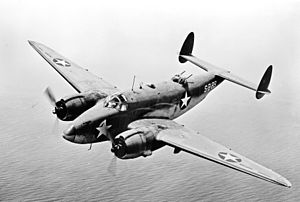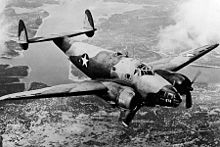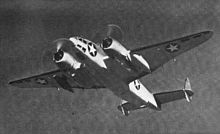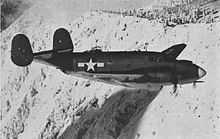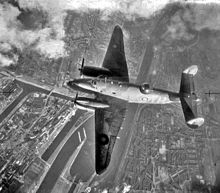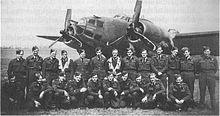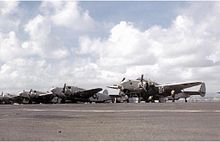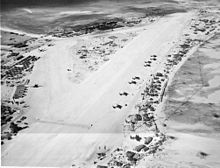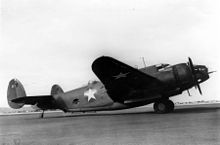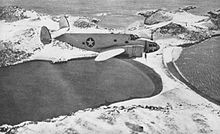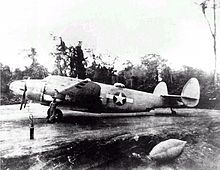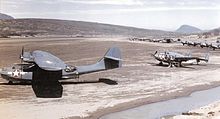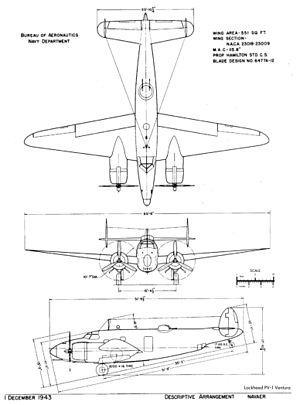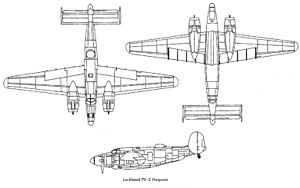- Lockheed Ventura
-
Ventura
B-34 Lexington / B-37
PV Ventura / HarpoonA Lockheed PV-1 Ventura Role Patrol bomber Manufacturer Lockheed Primary users United States Navy
United States Army Air Forces
Royal Air ForceDeveloped from Lockheed Model 18 Lodestar The Lockheed Ventura was a bomber and patrol aircraft of World War II, used by United States and British Commonwealth forces in several guises. It was developed from the Lockheed Model 18 Lodestar transport, as a replacement for the Lockheed Hudson bombers then in service with the Royal Air Force.
Contents
Development
Lockheed Ventura/B-34 Lexington
The Ventura was very similar to its predecessor, the Lockheed Hudson. The primary difference was not in layout; rather, the Ventura was larger and heavier than the Hudson. The RAF ordered 188 Venturas in February 1940. They were delivered from mid-1942 onwards. Venturas were initially used for daylight raids on occupied Europe. They proved unsuited to this task, because (like many other bombers used by the RAF), they were too vulnerable without long-range fighter escorts. They were replaced in this role by the de Havilland Mosquito. The Venturas were gradually transferred to patrol duties with Coastal Command, 30 went to the RCAF and some to the SAAF.
The RAF placed a further order for 487 Ventura Mark IIs, but many of these were diverted to United States Army Air Forces service. The U.S. Army Air Forces placed its own order for 200 Ventura Mark IIA, which were put into service as the B-34 Lexington. Later redesignated RB-34.
Lockheed B-37
In 1941 August, large orders for Venturas were placed with Lend-Lease Act money. Among the orders were for 550 armed reconnaissance versions of the Ventura. This plane was originally planned to be built under the designation O-56. The main differences between the Ventura and the O-56 were in the engines: rather than the 2,000 hp (1,491 kW) Pratt & Whitney R-2800 radials of the Ventura, the O-56 used 1,700 hp (1,270 kW) Wright R-2600-13 radials.
Before completion of the first O-56, the U.S. Army Air Forces dropped the O- category used to designate 'observation' (reconnaissance) planes. The O-56 was redesignated the RB-34B (RB- for 'reconnaissance bomber'). Before the first of these flew, the design was redesignated again as the B-37, because it used different engines.
RB was not used for Reconnaissance until after 1947. F was used for photo rec. R was used for Rotorcraft, which was changed to H for Helicopter after 1947. The RB designation WAS eventually given to these aircraft to represent a Redesignation - in this case to a training role.
While 550 were ordered by the Army Air Forces, acquisition by the USAAF stopped after only 18 were accepted, when the Army Air Forces agreed to turn over exclusive use of the Ventura to the United States Navy.
PV-1 Ventura
The PV-1 Ventura, built by the Vega Aircraft Company division of Lockheed (hence the 'V' Navy manufacturer's letter that later replaced the 'O' for Lockheed), was a version of the Ventura built for the U.S. Navy (see Venturas in U.S. Navy service below). The main differences between the PV-1 and the B-34 were the inclusion of special equipment in the PV-1, adapting it to its patrol-bombing role. The maximum fuel capacity of the PV-1 was increased from 1,345 gal (5,081 l) to 1,607 gal (6,082 l), to increase its range; the forward defensive armament was also reduced for this reason. The most important addition was of an ASD-1 search radar.
Early production PV-1s still carried a bombardier's station behind the nose radome, with four side windows and a flat bomb-aiming panel underneath the nose. Late production PV-1s dispensed with this bombardier position and replaced it with a pack with three 0.50 in (12.7 mm) machine guns underneath the nose. These aircraft could also carry eight 5 in (127 mm) HVAR rockets on launchers underneath the wings.
The PV-1 began to be delivered in 1942 December, and entered service in 1943 February. The first squadron in combat was VP-135, deployed in the Aleutian Islands in 1943 April. They were operated by three other squadrons in this theatre. From the Aleutians, they flew strikes against bases in Paramushiro and Shimushu, Japanese islands in the Kurile chain. Often, PV-1s would lead B-24 bomber formations, since they were equipped with radar. In late 1943, some PV-1s were deployed to the Solomon Islands as night-fighters.
PV-2 Harpoon
The PV-2 Harpoon was a major redesign of the Ventura with the wing area increased from 551 ft² (51.2 m²) to 686 ft² (63.7 m²) giving an increased load-carrying capability. The motivation for redesign was weaknesses in the PV-1, since it had shown to have poor-quality takeoffs when carrying a full load of fuel. On the PV-2, the armament became standardised at five forward-firing machine guns. Many early PV-1s had a bombardier's position, which was deleted in the PV-2. Some other significant developments included the increase of the bombload by 30% to 4,000 lb (1,800 kg), and the ability to carry eight 5-inch (127 mm) HVAR rockets under the wings.
While the PV-2 was expected to have increased range and better takeoff, the anticipated speed statistics were projected lower than those of the PV-1, due to the use of the same engines but an increase in weight. The Navy ordered 500 examples, designating them with the popular name Harpoon.
Early tests indicated a tendency for the wings to wrinkle dangerously. As this problem could not be solved by a 6 ft (1.8 m) reduction in wingspan (making the wing uniformly flexible), a complete redesign of the wing was necessitated. This hurdle delayed entry of the PV-2 into service. The PV-2s already delivered were used for training purposes under the designation PV-2C. By the end of 1944, only 69 PV-2s had been delivered. They finally resumed when the redesign was complete. The first aircraft shipped were the PV-2D, which had eight forward-firing machine guns and was used in ground attacks. When World War II ended, all of the order was cancelled.
With the wing problems fixed, the PV-2 proved reliable, and eventually popular. It was first used in the Aleutians by VP-139, one of the squadrons that originally used the PV-1. It was used by a number of countries after the war’s end, but the United States ceased ordering new PV-2s, and they were all soon retired from service.
Civil conversions
Ex-military PV-1 Venturas from Canada and South Africa were converted by Howard Aero in San Antonio, Texas in the 1950s and 60s as high-speed executive transports. The earliest conversions, called Super Venturas, incorporated a 48 in (122 cm) fuselage stretch, extra fuel tankage, large picture windows, luxury interiors, and weapons bays transformed into baggage compartments. The landing gear was swapped for the heavier-duty units from the PV-2. Later versions, built in the 1960s, were called Howard 350s.[1] At least fifteen PV-2s were further modified, including cabin pressurisation under the designation Howard 500. A final PV-1 modification by Howard was the Eldorado 700, with longer wings, a pointed nose, and streamlined engine cowlings.
Operational history
Royal Air Force
387 PV-1s were used by the RAF as the Ventura G.R.V. They were used in the Mediterranean and by Coastal Command. Some RAF aircraft were modified into Ventura C.V transport aircraft. The Ventura Mark I was first delivered to the Royal Air Force in September 1941, and flew its first combat mission on 3 November 1942 against a factory in Hengelo, the Netherlands. On 6 December 1942, 47 Venturas engaged in a daylight, low-altitude attack against Eindhoven, also in the Netherlands. This was the primary event that demonstrated the Ventura's weakness in such raids: of the 47, nine of the bombers were downed. Following this tragedy, tactics were switched to medium-altitude raids. The Ventura fared little better in this strategy. During one attack on a power station in Amsterdam on 3 May 1943, New Zealand's 487 Squadron was told the target was of such importance that the attack was to be continued regardless of opposition. All ten Venturas to cross the coast were lost to German fighters. Squadron Leader Leonard Trent, (later the last of the Great Escapers), won the Victoria Cross for his leadership in this raid.
It was never a very popular aircraft among RAF crews, and despite the fact that it was 50 mph (80 km/h) faster and carried more than twice as many bombs as its predecessor, the Hudson, it proved ill-suited to its task as a bomber. By the summer of 1943, the Ventura had been phased out of service in favour of the de Havilland Mosquito. Its last mission was flown by No. 21 Squadron RAF on 9 September 1943. After leaving bombardment service, a number were modified to be used by Coastal Command; they served as the Ventura G.R.I.
A small number of Venturas were also used in other countries, including Canada the Royal New Zealand Air Force and South Africa.
Royal Australian Air Force
A total of 55 PV-1s were used by the RAAF in the South West Pacific Area, serving primarily in New Guinea. Initially, air crews and ground staff disliked the Ventura, preferring the B-25 Mitchell. But in many cases, the PV-1 had developed a grudging respect from its operators.
Royal Canadian Air Force
Venturas were in use by the RCAF from 16 June 1942 to 18 April 1947 in the home defence coastal patrol role in both Eastern and Western Air Command. They were flown by 8, 113, 115, 145, and 149 Squadrons, as well as by 1 Central Flying School, Trenton, Ontario, and at RCAF Station Pennfield Ridge, New Brunswick (RAF No. 34 Operational Training Unit). They were also flown at RCAF Station Yarmouth in World War II.
A total of 21 Mk. Is, 108 Mk. IIs, and 157 G.R. Mk. Vs were in service during this period for a total of 286 aircraft.
South African Air Force
The South African Air Force also received some 135 PV-1s, which were used to protect shipping around the Cape of Good Hope, and to bomb Italian shipping in the Mediterranean. They were used by the South African Air Force up to 1960.
Royal New Zealand Air Force
From August 1942, No. 487 Squadron RNZAF, (operating in Europe as part of the Royal Air Force), was equipped with the type, although losses (including on 3 May 1943 the loss of all 11 aircraft attacking Amsterdam), lead to their replacement with the de Havilland Mosquito in June.
The Royal New Zealand Air Force in the Pacific received 139 Venturas and some Harpoons from June 1943 to replace Lockheed Hudsons in the maritime patrol bomber and medium bomber roles. Initially Venturas were unpopular with the RNZAF due to rumoured poor performance on one engine, the fate of Squadron Leader Leonard Trent VC's 487 Squadron (above) as well as the failure of the U.S. to provide New Zealand with promised B-24 Liberators. Despite that the RNZAF Venturas came to be amongst the most widely used of any nation's, seeing substantial action until VJ Day over South West Pacific islands.
The first 19 RB-34s that arrived by sea from the U.S. in June had much equipment either missing or damaged. Six airworthy machines were hurriedly produced by cannibalisation and sent into action with No. 3 Squadron RNZAF in Fiji. On 26 June the first PV-1s were flown to Whenuapai and No. 1 Squadron RNZAF was able to convert to 18 of these by 1 August, then replacing the mixed 3 Squadron in action at Henderson Field, Guadacanal in late October.
By this time No. 2 Squadron RNZAF at Ohakea and No. 9 Squadron RNZAF were also using the type. The following year No. 4 Squadron RNZAF and No. 8 Squadron RNZAF also received Venturas. Some squadrons were retained on garrison duty while others followed the allied advance to Emirau and Green Island and to New Britain. RNZAF Venturas were tasked with routine patrols, anti-shipping strikes, minelaying, bombing and strafing missions, air-sea rescue patrols, and photographic reconnaissance missions. In an apparently bizarre case of taking Lockheed's marketing slogan of The Fighter-Bomber too literally, even briefly, Venturas conducted fighter sweeps.
RNZAF machines often clashed with Japanese fighters, notably during an air-sea rescue patrol on Christmas Eve of 1943. NZ4509 was attacked by nine Japanese single-engined fighters over St. George's Channel. It shot down three, later confirmed, and claimed two others as probables, although it suffered heavy damage in the action. The pilot, Flying Officer D. Ayson and navigator, Warrant Officer W. Williams, were awarded the DFC. The dorsal turret gunner Flight Sergeant G. Hannah was awarded the DFM.
By late 1944 the Ventura began to be phased out of frontline action as the RNZAF backed away from the Patrol Bomber concept, orders for PV-2 Harpoons were cancelled after a handful or aircraft had been delivered. At VJ Day only 30 PV-1 aircraft remained on the front-line with No. 3 Squadron at Jacquinot Bay.
Planned re-equipment with Mosquitoes did not take place until after the cessation of hostilities. The last Ventura unit was No. 2 Squadron, which continued to operate PV-1 and PV-2 aircraft on meteorological duty until 1948. A restored RNZAF RB-34 (NZ4600) is owned by the Museum of Transport and Technology in Auckland.
United States Army Air Forces
Some 264 Ventura Mark IIs ordered by the RAF were seized by the U.S. Army Air Force. Though some were used as anti-submarine patrol bombers under the designation B-34 Lexington, most were used for training with various stateside units. 27 of these were used by the United States Navy for anti-submarine patrols as well; these were designated PV-1 Ventura and PV-2 Harpoon.
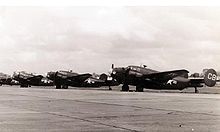 PV-2s of VPB-136 at NAS Whidbey Island, 1945-46.
PV-2s of VPB-136 at NAS Whidbey Island, 1945-46.
During the early months of 1942, the primary responsibility for anti-submarine warfare in the United States was shouldered by the Army Air Force. This irked the Navy, as it considered this region of battle its burden. To carry out such a task, the Navy was pursuing a long-range, land-based patrol and reconnaissance aircraft with a substantial bombload. This goal was always resisted by the Army Air Force, which carefully protected its monopoly on land-based bombing. This forced the navy to use long-range floatplanes for these roles. The Navy was unable to upgrade to more capable aircraft until the Army Air Force needed the Navy plant in Renton, Washington to manufacture its B-29 Superfortress. In exchange for use of the Renton plant, the Army Air Force would discontinue its objections to Naval land-based bombers, and provide planes to the Navy. One of the clauses of this agreement stated that production of the B-34 and B-37 by Lockheed would cease, and instead these resources would be directed at building a navalised version, the PV-1 Ventura.
The PV-1 began to be delivered in December 1942, and entered service in February 1943. The first squadron in combat was VP-135, deployed in the Aleutian Islands in April 1943. They were operated by three other squadrons in this theatre. From the Aleutians, they flew strikes against Paramushiro, a Japanese island. Often, PV-1s would lead B-24 bomber formations, since they were equipped with radar. In late 1943, PV-1s were deployed to the Solomon Islands and to the newly captured field at Tarawa in the Gilbert Islands.
After the war the US Navy deemed many PV-1s as obsolete and the aircraft were sent to Naval Air Station Clinton, Oklahoma to be demilitarized and reduced to scrap.
Other operators
- Brazil (15 Venturas, 5 Harpoons)
- Italy (22 Harpoons)
- Japan (17 Harpoons)
- Netherlands
- Peru (6 Harpoons)
- Portugal (42 Harpoons)
Variants
- B-34
- US designation for the Model 137 (with 2000hp R-1820-31 engines) bought for the Royal Air Force, 200 built and designated the Ventura IIA by the British.[2]
- B-34A
- Former Royal Air Force Venturas returned to USAAF under a reverse lend-lease.[2]
- B-34B
- B-34As converted as navigation trainers.[2]
- B-37
- Lockheed Model 437 for the USAAF (with 2000hp R-2600-13 engines), only 18 out of an order of 550 built for armed observation. Originally designated the O-56, it was later designated the RB-37.[2]
- PV-1
- United States Navy version of the B-34; 1,600 built. A total of 388 were delivered to the Royal Air Force as the Ventura GR.V, others to the RAAF, RNZAF and SAAF.[2]
- PV-1P
- Designation for PV-1s fitted with a camera installation.[2]
- PV-2 Harpoon
- Updated model with larger fin and wing area; 470 built.[2]
- PV-2C
- Modified version of the PV-2 used for training; 30 built.[2]
- PV-2D
- Same as PV-2 but with eight 0.5in nose guns; 35 built.[2]
- PV-2T
- Designation for PV-2s used for crew training.[2]
- PV-3
- Twenty-seven former RAF Ventura IIs requisitioned by the USN.[2]
- Ventura I
- R-2800-S1A4-G powered variant for the Royal Air Force; 188 built, 30 to the RCAF and some to the SAAF, later re-designated the Ventura GR.I.[2]
- Ventura II
- R-2800-31 powered variant for the RAF, 487 built, some transferred to the USAAC and USN.[2]
- Ventura IIA
- British designation for the B-34.[2]
- Ventura V
- British designation for the PV-1, later designated Ventura GR.V.[2]
Operators
- Brazilian Air Force
- 1st Medium Bomber Group
- Royal Canadian Air Force
- No. 8 Squadron RCAF
- No. 113 Squadron RCAF
- No. 115 Squadron RCAF
- No. 145 Squadron RCAF
- No. 149 Squadron RCAF
- No. 34 OTU, Pennfield Ridge, New Brunswick
- French Navy - Aeronavale
- Escadrille 11S (PV-1 from 1947 to 1953 and 6 PV-2 from 1953 to 1960) for transport duty only.
- Japan Maritime Self-Defense Force
- Kanoya Flying Training Wing
- New Zealand Air Force
- No. 1 Squadron RNZAF
- No. 2 Squadron RNZAF
- No. 3 Squadron RNZAF
- No. 4 Squadron RNZAF
- No. 8 Squadron RNZAF
- No. 9 Squadron RNZAF
- No. 487 Squadron RNZAF
- No. 1 (B) OTU
- No. 14 Servicing Unit
- South African Air Force
- 17 Squadron SAAF
- 22 Squadron SAAF
- 23 Squadron SAAF
- 25 Squadron SAAF
- 27 Squadron SAAF
- 29 Squadron SAAF
- 60 Squadron SAAF
- Royal Air Force
- No. 13 Squadron RAF (Coastal Command)
- No. 21 Squadron RAF
- No. 299 Squadron RAF
- No. 500 Squadron RAF
- No. 519 Squadron RAF (Coastal Command)
- No. 521 Squadron RAF (Coastal Command)
- No. 624 Squadron RAF
- United States Marine Corps
- VMF(N)-531
- United States Navy
- VB/VPB-125
- VB/VPB-126
- VB/VPB-127
- VB/VPB-128
- VB/VPB-129
- VB/VPB-130
- VB/VPB-131
- VB/VPB-132
- VB/VPB-133
- VB/VPB-134
- VB/VPB-135
- VB/VPB-136
- VB/VPB-137
- VB/VPB-138
- VB/VPB-139
- VB/VPB-140
- VB/VPB-141
- VB/VPB-142
- VB/VPB-143
- VB/VPB-144
- VB/VPB-145
- VB/VPB-146
- VB/VPB-147
- VB/VPB-148
- VB/VPB-149
- VB/VPB-150
- VB/VPB-151
- VB/VPB-152
- VB/VPB-153
- VB/VPB-200
- VD-2
Survivors
Airworthy
- United States
- PV-2 Harpoon, BuNo. 37211 is airworthy and owned by Palm Springs Air Museum in Palm Springs, California.[3]
- PV-2 Harpoon, BuNo. 37396 is airworthy and owned by the American Military Heritage Foundation in Indianapolis, Indiana.[4]
- PV-2 Harpoon, BuNo. 37472 is airworthy and owned by the Warbird Aircraft Sales LLC in Heber City, Utah.[5]
- PV-2 Harpoon, BuNo. 37634 is airworthy and owned by the Lone Star Flight Museum in Galveston, Texas[6]
- PV-2 Harpoon, BuNo. 84062 is airworthy and owned by the Everts Air Fuel Inc. in Fairbanks, Alaska[7]
On display
- New Zealand
- RB-34 Ventura, (s/n 41-38117) is on display at the Museum of Transport and Technology in Auckland.[8]
- South Africa
- PV-1 Ventura, BuNo. 34759 is on display at the Dickie Fritz Shell Hole M.O.T.H. compound in Johannesburg.[9]
- United States
- Ventura Mk.II, (s/n AJ311) is on display at the Pueblo Weisbrod Aircraft Museum in Pueblo, Colorado. It is on loan from the National Museum of the United States Air Force in Dayton, Ohio[10]
- PV-2 Harpoon, BuNo. 37230 is on display at the National Museum of Naval Aviation in Pensacola, Florida.[11]
- PV-2 Harpoon, BuNo. 37257 is on display at the Pima Air Museum in Tucson, Arizona.[12]
Under restoration
- Australia
- PV-1 Ventura, BuNo. 49555 is under restoration by the Queensland Air Museum in Caloundra, Queensland.[13]
- Canada
- PV-1 Ventura, BuNo. 33315 is under restoration by the Ventura Memorial Flight Association in Edmonton, Alberta.[14]
- United States
- PV-1 Ventura, BuNo. unknown is under restoration by at the NAS Sanford Memorial Park in Sanford, Florida.[15]
- PV-1 Ventura, BuNo. 34604 is under restoration to airworthiness by Air Carriers Inc. in North Miami, Florida.[16]
- PV-1 Ventura, BuNo. 34670 is under restoration to airworthiness by TP Universal Exports International LLC in Eagan, Minnesota.[17]
- PV-1 Ventura, BuNo. 34804 is under restoration to airworthiness by Skyrider Airfreight Inc. in Tulsa, Oklahoma.[18]
- PV-2 Harpoon, BuNo. 37107 is under restoration to airworthiness by Tim Savage in Roanoke, Indiana.[19]
- PV-2 Harpoon, BuNo. 37129 is under restoration to airworthiness by Quarry Products Inc. in Richmond, California.[20]
- PV-2 Harpoon, BuNo. 37171 is under restoration to airworthiness by Neil Rose in Vancouver, Washington.[21]
- PV-2 Harpoon, BuNo. 37202 is under restoration to airworthiness by Fantasy of Flight in Polk City, Florida.[22]
- PV-2 Harpoon, BuNo. 37216 is under restoration to airworthiness by Earl Benedict in Napa, California.[23]
- PV-2 Harpoon, BuNo. 37234 is under restoration to airworthiness by Constance Hirth of Buffalo, Wyoming.[24]
- PV-2 Harpoon, BuNo. 37254 is under restoration to airworthiness by Southwest Aviation Inc. of Fairacres, New Mexico.[25]
- PV-2 Harpoon, BuNo. 37276 is under restoration to airworthiness by Constance Hirth of Buffalo, Wyoming.[26]
- PV-2 Harpoon, BuNo. 37419 is under restoration to airworthiness by Quarry Products Inc. in Richmond, California.[27]
- PV-2 Harpoon, BuNo. 37466 is under restoration to airworthiness by Mitchell Aircraft Corp. in Chino, California.[28]
- PV-2 Harpoon, BuNo. 37499 is under restoration to airworthiness by Constance Hirth in Buffalo, Wyoming.[29]
- PV-2 Harpoon, BuNo. 37524 is under restoration to airworthiness by Earl Benedict in Bangor, California.[30]
- PV-2 Harpoon, BuNo. 37535 is under restoration to airworthiness by Jack Erickson in Beaverton, Oregon.[31]
- PV-2 Harpoon, BuNo. 37550 is under restoration to airworthiness by the United States Airpower Museum in Fresno, California.[32]
- PV-2 Harpoon, BuNo. 37633 is under restoration to airworthiness by Robert Kropp in Mesa, Arizona.[33]
- PV-2 Harpoon, BuNo. 84060 is under restoration to airworthiness by the Cavanaugh Flight Museum in Addison, Texas.[34]
- PV-2 Harpoon, BuNo. 84064 is under restoration to airworthiness by S.I. Vorschoot DBA in Glendive, Montana.[35]
Specifications (B-34 Lexington)
Data from[citation needed]
General characteristics
- Crew: 6
- Length: 51 ft 5 in (15.7 m)
- Wingspan: 65 ft 6 in (20 m)
- Height: 11 ft 10 in (3.6 m)
- Wing area: 551 ft² (51.2 m²)
- Empty weight: 20,197 lb (9,160 kg)
- Loaded weight: 31,000 lb (14,000 kg)
- Max takeoff weight: 34,000 lb (15,000 kg)
- Powerplant: 2 × Pratt & Whitney R-2800 radial engines, 2,000 hp (1,500 kW) each
Performance
- Maximum speed: 322 mph (518 km/h)
- Cruise speed: 230 mph (370 km/h)
- Range: 1,660 mi (2,670 km)
- Ferry range: 2,600 mi (4,200 km)
- Service ceiling: 26,300 ft (8,020 m)
- Rate of climb: 2,035 ft/min (15.4 m/s)
- Wing loading: 56.4 lb/ft² (275 kg/m²)
- Power/mass: 0.13 hp/lb (0.21 kW/kg)
Armament
- Guns:
- 4 × .50 in (12.7 mm) Browning M2 machine guns
- 2 × .30 in (7.62 mm) M1919 Browning machine guns
- Bombs:
- 3,000 lb (1,400 kg) general ordnance or
- 6 × 325 lb (147 kg) depth charges or
- 1 × torpedo
See also
- Lockheed PV-2 Harpoon No. 37396
- Related development
- Related lists
- List of military aircraft of the United States
- List of military aircraft of the United States (naval)
- List of bomber aircraft
- List of Lockheed aircraft
- List of aircraft of World War II
References
- Notes
- ^ Taylor 1965, p.244.
- ^ a b c d e f g h i j k l m n o Andrade 1979, pp. 82–83, 207–208, 247.
- ^ "PV-2 Harpoon/37211" FAA Registry. Retrieved: 1 June 2011.
- ^ "PV-2 Harpoon/37396" FAA Registry. Retrieved: 1 June 2011.
- ^ "PV-2 Harpoon/37472" FAA Registry. Retrieved: 1 June 2011.
- ^ "PV-2 Harpoon/37634" FAA Registry. Retrieved: 1 June 2011.
- ^ "PV-2 Harpoon/84062" FAA Registry. Retrieved: 1 June 2011.
- ^ "RB-34 Ventura/41-38117" Warbirds Resource Group. Retrieved: 20 April 2011.
- ^ "PV-1 Ventura/34759" Warbirds Resource Group. Retrieved: 20 April 2011.
- ^ "Ventura Mk.II/AJ311" Warbirds Resource Group. Retrieved: 20 April 2011.
- ^ "PV-2 Harpoon/37230" Warbirds Resource Group. Retrieved: 20 April 2011.
- ^ "PV-2 Harpoon/37257" Pima Air Museum. Retrieved: 20 April 2011.
- ^ "PV-1 Ventura/49555" Warbird Registry. Retrieved: 1 June 2011.
- ^ "PV-1 Ventura/33315" Warbird Registry. Retrieved: 1 June 2011.
- ^ "PV-1 Ventura/unknown" NAS Sanford Memorial. Retrieved: 20 April 2011.
- ^ "PV-1 Ventura/34604" FAA Registry. Retrieved: 1 June 2011.
- ^ "PV-1 Ventura/34670" FAA Registry. Retrieved: 1 June 2011.
- ^ "PV-1 Ventura/34804" FAA Registry. Retrieved: 1 June 2011.
- ^ "PV-2 Harpoon/37107" FAA Registry. Retrieved: 1 June 2011.
- ^ "PV-2 Harpoon/37129" FAA Registry. Retrieved: 1 June 2011.
- ^ "PV-2 Harpoon/37171" FAA Registry. Retrieved: 1 June 2011.
- ^ "PV-2 Harpoon/37202" FAA Registry. Retrieved: 1 June 2011.
- ^ "PV-2 Harpoon/37216" FAA Registry. Retrieved: 1 June 2011.
- ^ "PV-2 Harpoon/37234" FAA Registry. Retrieved: 1 June 2011.
- ^ "PV-2 Harpoon/37254" FAA Registry. Retrieved: 1 June 2011.
- ^ "PV-2 Harpoon/37276" FAA Registry. Retrieved: 1 June 2011.
- ^ "PV-2 Harpoon/37419" FAA Registry. Retrieved: 1 June 2011.
- ^ "PV-2 Harpoon/37466" FAA Registry. Retrieved: 1 June 2011.
- ^ "PV-2 Harpoon/37499" FAA Registry. Retrieved: 1 June 2011.
- ^ "PV-2 Harpoon/37524" FAA Registry. Retrieved: 1 June 2011.
- ^ "PV-2 Harpoon/37535" FAA Registry. Retrieved: 1 June 2011.
- ^ "PV-2 Harpoon/37550" FAA Registry. Retrieved: 1 June 2011.
- ^ "PV-2 Harpoon/37633" FAA Registry. Retrieved: 1 June 2011.
- ^ "PV-2 Harpoon/84060" FAA Registry. Retrieved: 1 June 2011.
- ^ "PV-2 Harpoon/84064" FAA Registry. Retrieved: 1 June 2011.
- Bibliography
- Andrade, John. U.S. Military Aircraft Designations and Serials since 1909. Hersham, Surrey, UK: Midland Counties Publications, 1979. ISBN ISBN 0-904597-22-9.
- Carey, Alan C. PV Ventura / Harpoon Units of World War 2 (Osprey Combat Aircraft 34). Botley, UK: Osprey Publishing, 2002. ISBN 1-84176-383-7.
- Roberts, Michael D., Captain, MSC, USNR (Ret.).Dictionary of American Naval Aviation Squadrons, Volume 2: The History of VP, VPB, VP(H) and VP(AM) Squadrons. Washington, DC: Naval Aviation History Office, 2000.
- Scrivner, Charles L. and W.E. Scarborough, Captain USN (ret). Lockheed PV-1 Ventura in Action. Carrollton, Texas: Squadron/Signal Publications, Inc., 1981. ISBN 0-89747-118-0.
- Stanaway, John C. Vega Ventura: The Operational Story of Lockheed's Lucky Star. Atglen, PA: Schiffer Publishing, 2000. ISBN 0-7643-0087-3.
- Taylor, John W. R. Jane's All The World's Aircraft 1965-66. London: Sampson Low, Marston, 1965.
External links
- The aircraft in Lake Washington.
- USAF Museum B-34 fact sheet
- USAF Museum B-37 fact sheet
- "The Versatile Ventura" June 1945 Popular Science -- note: rare photos of loading of various weapon loads
- Ralls Clotfelter, 2003, "PV-1 Ventura in the Pacific – Lockheed's forgotten warbird" (archive.org copy of the original as of 3 April 2007 )
- Encyclopedia of American Aircraft
- US Navy Patrol Squadrons
- PBS Nova program about "Bomber 31"
- Web site about RNZAF use
- Ventura Memorial Flight Association (VMFA)
- Alberta Aviation Museum
- American Military Heritage Foundation (AMHF)
- Lockheed Twins Site - civil Ventura conversions
- 1946 manual AN 01-55ED-1 Pilots Handbook for Navy Model PV-2 PV-2C PV-2D Airplanes
- Alan Carey author of PV Ventura and Harpoon Units [http://en.wikipedia.org/wiki/Alan_C._Carey
Lockheed and Lockheed Martin aircraft Manufacturer
designationsBasic Model
NumbersL-1 · L-2 · L-3 · L-4 · L-5 · L-7 · L-8 · L-9 · L-10 · L-11 · L-012 · (L-013 not assigned) · L-014 · L-015 · L-016 · L-017 · L-018 · L-019 · L-020 · L-021 · L-022 · L-023 · L-024 · (L-025 not assigned) · L-026 · L-027 · (L-028 not assigned) · L-029 · L-030 · L-031 · L-032 · L-033 · L-034 · L-035 · (L-036 not assigned) · L-037 · (L-038 and L-039 not assigned) · L-040 · L-041 · L-042 · L-044 · L-045 · L-049 · L-050 · L-051 · L-052 · L-060 · L-061 · L-062 · L-075 · L-080 · L-081 · L-082 · L-083 · L-084 · L-085 · L-086 · L-087 · L-088 · L-089 · L-090 · L-091 · L-092 · L-093 · L-094 · L-092 · L-099 · L-100 · L-133 · L-140 · L-141 · L-193 · L-245 · L-246 · L-300 · L-301 · L-329 · L-351 · L-382 · L-500 · L-645
Lockheed-California
Temporary Design
NumbersBy role Airliners and
civil transportsVega · Sirius · Altair · Orion · Electra · Electra Junior · Super Electra · Lodestar · Constellation (L-049 · L-649 · L-749) · Super Constellation (L-1049 · L-1249) · Starliner · Saturn · Electra · L-402 · JetStar · L-100 · L-1011
Military transportsY1C-12 · Y1C-17 · Y1C-23 · Y1C-25 · C-36 · C-37 · C-40 · C-56 · C-57 · C-59 · C-60 · C-63 · C-66 · C-69 · UC-85 · UC-101 · C-104 · C-111 · C-121 · C-130 / C-130J / HC-130 / KC-130 / LC-130 / MC-130 · C-139 · C-140 · C-141 · C-5 · JO · XRO · R2O · R3O · XR4O · R5O · R6O / R6V · R7O / R7V · R8V / GV / UV · TriStar
Attack and bombersDrones/UAVsEW and
reconnaissanceFightersHelicoptersMaritime patrolTrainersExperimentalNames Air Express · Aquila · Altair · Aurora · Big Dipper · Blackbird · Chain Lightning · Cheyenne · Constellation (L-049 · L-649 · L-749) · Constitution · Electra (Model 10) · Electra (Model 88) · Electra Junior · Excalibur · Explorer · Fighting Falcon · Galaxy · Have Blue · Hercules · Hudson · Hummingbird · JetStar · Kestrel · Kingfisher · Lightning · Lightning II · Little Dipper · Lodestar · Neptune · Orion (Model 9) · Orion (P-3) · Polecat · Raptor · Saturn · SeaStar · Sentinel · Shooting Star · Sirius · Starfighter · Starfire · Starlifter · Starliner · Super Constellation (L-1049 · L-1249) · Super Electra · Super Galaxy · Super Hercules · Tristar · Vega · Ventura · Viking · Warning Star
USAAS/USAAC/USAAF/USAF bomber designations 1924–1962 Bomber XB-1 · B-2 · B-3 · B-4 · B-5 · B-6 · Y1B-7 · XB-8 · YB-9 · B-10 · YB-11 · B-12 · XB-13 · XB-14 · XB-15 · XB-16 · B-17 · B-18 · XB-19 · Y1B-20 · XB-21 · XB-22 · B-23 · B-24 · B-25 · B-26 · XB-27 · XB-28 · B-29 · XB-30 · XB-31 · B-32 · XB-33 · B-34 · YB-35 · B-36 · B-37 · XB-38 · XB-39 · YB-40 · XB-41 · XB-42 · XB-43 · XB-44 · B-45 · XB-46 · B-47 · XB-48 · YB-49 · B-50 · XB-51 · B-52 · XB-53 · B-54 · XB-55 · XB-56 · B-57 · B-58 · XB-59 · YB-60 · B-61 · B-62 · B-63 · B-64 · B-65 · B-66 · B-67 · XB-68/SM-68 · RB-69 · XB-70 · SR-71
Light bomber Heavy bomber XHB-1 · XHB-2 · XHB-3
Long-range bomber USAAC/USAAF observation aircraft Observation O-1 • O-2 • XO-3 • XO-4 • O-5 • O-6 • O-7 • O-8 • O-9 • XO-10 • O-11 • O-12 • O-14 • XO-14 • XO-15 • XO-16 • O-17 • XO-18 • O-19 • YO-20 • XO-21 • O-22 • YO-23 • O-24 • O-25 • Y1O-26 • Y1O-27 • O-28 • O-29 • O-30 • O-31 • O-32 • Y1O-33 • O-34 • O-35 • XO-36 • O-37 • O-38 • O-39 • O-40 • Y1O-41 • O-42 • O-43 • XO-44 • O-45 • O-46 • O-47 • XO-48 • O-49 • YO-50 • YO-51 • O-52 • O-53 • YO-54 • YO-55 • O-56 • O-57 • O-58 • O-59 • O-60 • XO-61 • O-62 • XO-63
Observation Amphibian USN/USMC patrol aircraft designations 1923-1962 Patrol HallKeystonePN • P2N • P4N
LockheedPOSikorskyPS • P2S
LockheedPatrol Bomber XPBB • PB2B
LockheedSikorskyPBSVickers CanadaPatrol Torpedo Bomber HallLists relating to aviation General Aircraft (manufacturers) · Aircraft engines (manufacturers) · Airlines (defunct) · Airports · Civil authorities · Museums · Registration prefixes · Rotorcraft (manufacturers) · TimelineMilitary Accidents/incidents Records Categories:- Lockheed aircraft
- United States bomber aircraft 1940–1949
- United States patrol aircraft 1940–1949
- World War II patrol aircraft of the United States
Wikimedia Foundation. 2010.

